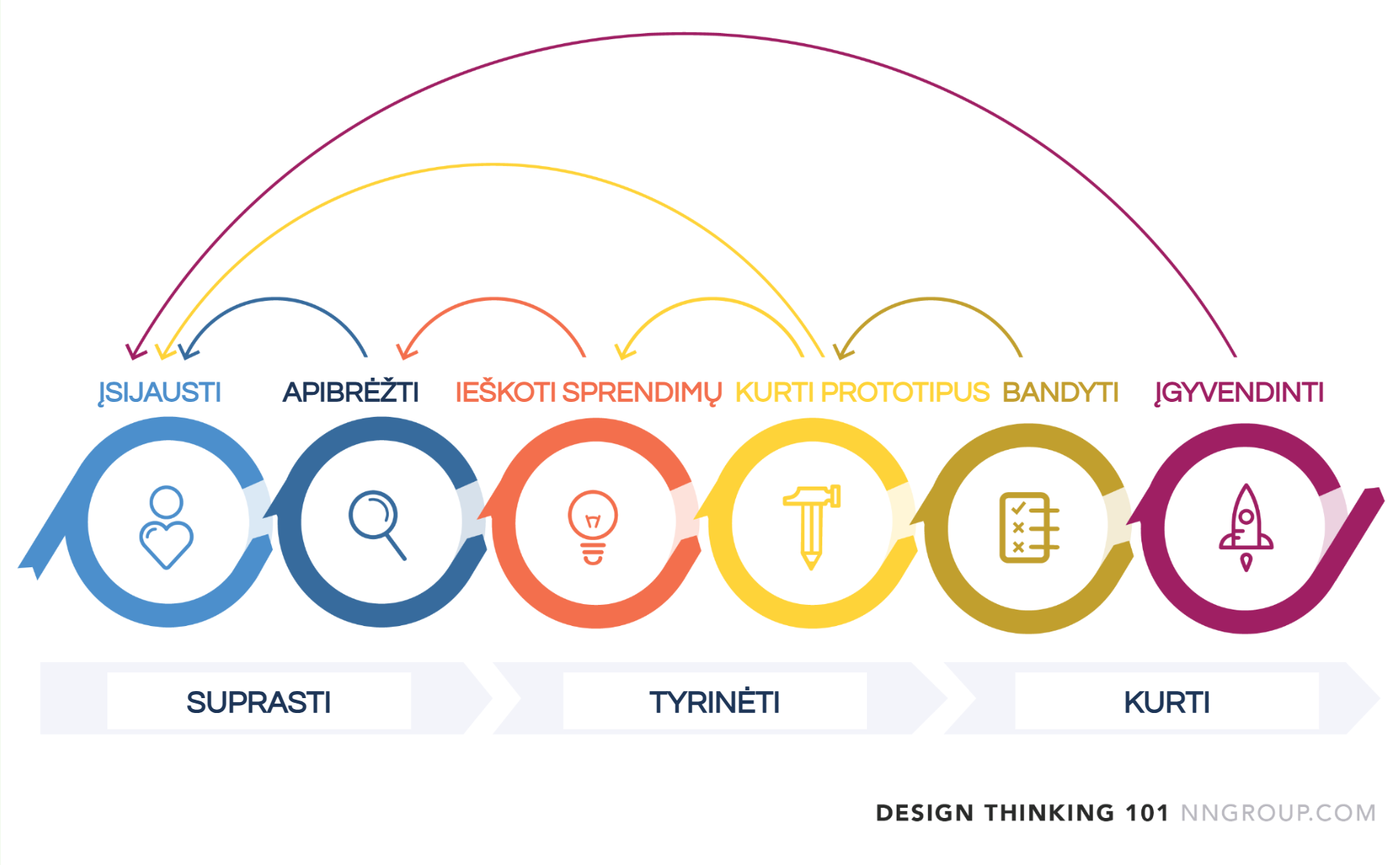1
Į žmogų orientuotas dizaino mąstymas
Į žmogų orientuotas dizaino mąstymas
Apie
Į žmogų orientuotas dizaino mąstymas yra kūrybiškas ir bendradarbiavimu grįstas problemų sprendimo metodas, kuris prasideda nuo žmonių. Jis skatina mus giliai suprasti tų, su kuriais dirbame – šiuo atveju, jaunų žmonių – poreikius, lūkesčius ir iššūkius.
Užuot iš karto einant prie sprendimų, šis metodas kviečia klausti, klausytis, empatiškai įsijausti ir kartu kurti idėjas, kurios iš tiesų yra prasmingos. Jis apima penkis pagrindinius etapus: įsijausti, apibrėžti, generuoti idėjas, kurti prototipus ir išbandyti. Vis dėlto jie ne visada vyksta griežta tvarka. Priklausomai nuo dizaino mokyklos, šie etapai gali būti vadinami skirtingai, o kai kuriais atvejais jų gali būti ir daugiau.

Pavyzdžiui, IDEO agentūra, garsėjanti savo į žmogų orientuoto dizaino darbais, pristato detalesnius žingsnius toje pačioje eigoje: suformuluoti klausimą – rinkti įkvėpimą – apibendrinti įžvalgas – generuoti idėjas – paversti idėjas apčiuopiamomis – testuoti, kad išmoktum – pasidalinti istorija.

Darbas su jaunimu ir neformalusis ugdymas, orientuotas į žmogų, suteikia galimybę:
- Įtraukti jaunus žmones kaip partnerius, o ne tik dalyvius.
- Kurti programas, įrankius ir sprendimus, atliepiančius realius poreikius.
- Ugdyti kūrybinį pasitikėjimą savimi ir bendradarbiavimo dvasią procese.
Šioje veikloje nagrinėsi įsijautimo (Empathise) etapą – vieną iš kertinių į žmogų orientuoto mąstymo elementų, kuris padeda atrasti įžvalgas klausantis ir stebint.
1. Skaityk daugiau apie konkrečius į žmogų orientuoto dizaino mąstymo aspektus, sutelkiant dėmesį į įsijautimo (Empathise) ir apibrėžimo (Define) etapus.
2. Žiūrėk: „Design Thinking Process“ – paprastas animuotas paaiškinamasis vaizdo įrašas.
3. Pasidalink savo įžvalgomis
Įkelkite vieną įžvalgą arba netikėtą atradimą iš savo empatijos žemėlapio.
Apie tai pagalvokite: kaip tai pakeitė jūsų supratimą apie iššūkį? Kaip ši įžvalga galėtų paveikti sprendimą, orientuotą į jaunus žmones?
Medžiaga
Gauk veiklos ženkliuką
Į žmogų orientuoto dizaino mąstytojas Gauk šį ženkliuką
Aš gavau šį ženkliuką, tyrinėdamas į žmogų orientuoto dizaino mąstymo metodą ir praktikuodamas empatijos žemėlapių sudarymą, kad geriau suprasčiau kitų poreikius ir patirtis. Įsitraukiau į prasmingus pokalbius, atidžiai klausiausi ir prisidėjau prie bendro realių iššūkių, su kuriais susiduria jaunimo darbuotojai, supratimo kūrimo. Ši patirtis sustiprino mano gebėjimą siekti inovacijų su empatija, smalsumu ir refleksija.
Šis ženkliukas yra KA2 bendradarbiavimo partnerystės projekto Learn INN, kurį remia Europos Sąjungos Erasmus+ programa, dalis.
Užduotys
Užduotis nr.1
Įrodymus patikrino: vienas renginio organizatorius
Pasidalykite viena įžvalga ar momentu iš savo „empatijos“ etapo darbo, kuris padėjo geriau suprasti tikrą poreikį ar iššūkį jūsų organizacijoje.
(Galite parašyti savo atsakymą arba įkelti paveikslėlį su trumpu komentaru.)
Įgūdžiai
ETS-TR
#Choose and designing appropriate methods for collecting, interpreting and disseminating information (data, resources, findings, etc.)
ETS-TR
#Where applicable, includes the community’s needs in the programme design
ESCO
#demonstrate empathy
Organizatoriai
Awero
Badge issuer recognized with
Panaudota grojaraščiuose
'LearnINN' – inovacijų kūrimas darbe su jaunimu
AweroSukurta Youth Work Pathways
Awero palaiko šią platformą ir plėtoja ją kartu su pagrindinėmis švietimo organizacijomis. Europos Sąjungos programa Erasmus+ dalinai finansavo pirmosios platformos versijos sukūrimą. Susisiekite su mumis support@Awero.org.
Platforma
Pakeisti į kitą kalbą:

